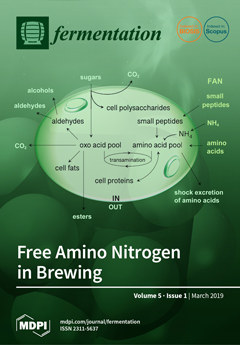In this study, microbial growth kinetics and modeling of alcohols production using
Saccharomyces cerevisiae were evaluated using different hydrolysates in a single pot (batch) system. Mixed agro-waste hydrolysates from different pre-treatment methods, i.e.,
N. mirabilis/CP and HWP/DAP/CP, were used as the sole
[...] Read more.
In this study, microbial growth kinetics and modeling of alcohols production using
Saccharomyces cerevisiae were evaluated using different hydrolysates in a single pot (batch) system. Mixed agro-waste hydrolysates from different pre-treatment methods, i.e.,
N. mirabilis/CP and HWP/DAP/CP, were used as the sole nutrient source in the fermentations used to produce the alcohols of interest. The maximum
Saccharomyces cerevisiae concentration of 1.47 CFU/mL (×10
10) was observed with HWP/DAP/CP hydrolysates, with a relative difference of 21.1% when compared to the
N. mirabilis/CP cultures; the product yield based on biomass generation was relatively (20.2%) higher for the
N. mirabilis/CP cultures. For the total residual phenolic compounds (TRPCs) generation, a relative difference (24.6%) between
N. mirabilis/CP and HWP/DAP/CP pre-treatment systems was observed, suggesting that
N. mirabilis/CP generates lower inhibition by-products. This was further evidenced by the lowest substrate utilization rate (3.3 × 10
−4 g/(L·h)) for the
N. mirabilis/CP cultures while achieving relatively similar product formation rates to those observed for the HWP/DAP/CP. A better correlation (
R2 = 0.94) was obtained when predicting substrate utilization for the
N. mirabilis/CP cultures. Generally, the pre-treatment of mixed agro-waste using
N. mirabilis/CP seemed appropriate for producing hydrolysates which
Saccharomyces cerevisiae can effectively use for alcohol production in the biorefinery industry.
Full article





